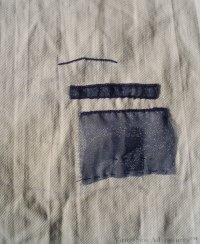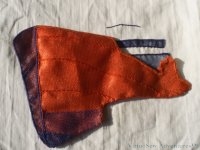The Camberwell Panel – Five
This shows the start of the work on the cotton twill which will form the basis for the hull and superstructure. I have used two layers of navy gauze where the shadows need to be darker and cut sections out of one of the layers where I want a lighter shade. The transferred outline – made using an iron-on transfer pencil – barely shows at all, and fades with age, so there is little risk of anything showing where it should not.
As the additional slip for the hull will cover the raw ends of the fabrics, I decided only to sew down firmly those elements that will be unprotected. I found that as I added embroidery and fabrics to my slips-in-preparation, they shrank – not something my books had ever mentioned, although it really should have occurred to me. That is why I ran the gauze down into the area which would be covered by the hull, although I only caught it down lightly. Although there will be padding under the hull, I was afraid that a strongly stitched line might show where it wasn’t wanted.
It is hard to see what I’m aiming for in these photos of the work in progress, so in this picture I have overlaid the slip made for the hull on the cotton drill in approximately the correct place to show the general effect I hope to achieve.
It was at about this point that the project woke up and started talking to me.
Before you book my place in an asylum, let me explain: that’s how I describe the feeling of having a near-absolute certainty of what to do next or how to achieve the next stage. Some of my projects never really do wake up, but the Camberwell chattered incessantly for the next several months, even when I decided to undo and redo some elements. When I was in doubt, I found that if I could in some way lay out the choices, they became blindingly obvious as soon as they progressed from imagination to fabric.
That made the Camberwell enormous fun to work on!



I was surprised at how many pieces there were to this project. It ended up reminding me of the Airfix model sailing ships I used to make in my teens. My mother thought it was a very odd thing for a girl to do.
I was not surprised to find the Camberwell was “talking” to Rachel. I often feel the same way about my interior design projects and have been known to say something like “I must ask the bedroom what it thinks about this cushion or that chair”.
Some projects just take on a life of their own. I was stitching the faces of the gods from the roof of a Pagoda and after a while they got into my brain and I had to stop.
How wonderful when a project takes on its own life and you know exactly what you want to do!
It’s magical when they start talking back. I find though that some of mine don’t speak English, which can be kind of tricky. Fascinating to see how those two little fragments fit together and how the picture will build up around it.
I know exactly what you meant! For my rugs, I’m often asked how I decide stitches to use for various elements. I have no way of explaining – I start to work on a motif, and it tells me exactly which stitch would work. This is coming along soooo well. Can’t wait to see more!
well I would have to join you in the asylum because my work talks to me too.
That Hull has certainly woken up and started chatting! It looks fab! My work doesn’t speak to me. But I have long conversations with myself in Spanish when I’m in the bath, so perhaps you, Karen and I need a triple room at that asylum.